The following review of a “lost” story of The Shadow is taken from my book The Shadow in Review: The Ultimate Guide to the Pulp Magazine Series.
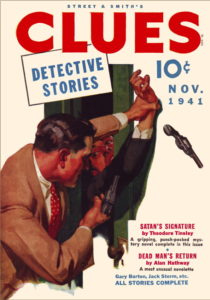
“Satan’s Signature” was originally published in the November 1941 issue of Clues magazine, after being rejected by The Shadow Magazine… and rewritten. Wealthy Andrew Thorpe was dead when Detective Walt Kenny arrived in answer to his phone call. Heart attack. And then Walt Kenny found that the dead man’s will had bequeathed a million dollars to an unknown heir — with Death the executor! And Kenny was on the trail of a phantom killer.
This is the Shadow mystery that Shadow readers never got to see. It was submitted in September 1939 under the title “The Phantom Killer.” But, it was banned by the editors of Street & Smith for being too extreme… a taboo breaker. Never one to waste a pulp story, Street & Smith had author Ted Tinsley did a quick rewrite and printed it in the November 1941 issue of Clues, under the title “Satan’s Signature.”
So, just what taboo did Tinsley break? If you’re like me, that’s the first question that pops into your mind. So here it is.
Spoiler Alert!
He had the master villain be an old woman… who, when caught, commits suicide. Yes, that was a deal-breaker for The Shadow Magazine. In the magazine series, women were treated more gently. They were almost always pure and innocent. Occasionally, author Walter B. Gibson would write in a moll… a girlfriend of a gangster whose actions are shady. A couple of times Gibson tried to trick readers into thinking that a woman was the master criminal, but in the end it turned out she was innocent. It was Theodore Tinsley who pushed the envelope and put women in the role of the guilty. But never the chief baddie. And certainly never was a woman allowed to commit suicide. That’s where he stepped over the line in this story.
The master criminal turns out to be old Martha Jackson. And in a pique of fury, she bites down on her fake pearls and swallows the poison hidden within. Street & Smith liked the story, but realized it couldn’t be published as a Shadow mystery.
End of Spoiler
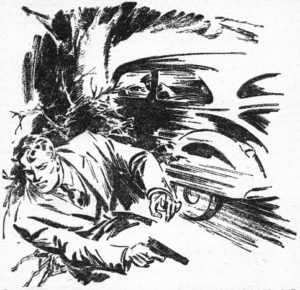
Theodore Tinsley first started writing for The Shadow in 1936 with “Partners of Peril”. Street & Smith wanted someone who could ease the pressure on Walter Gibson by writing four Shadow pulp stories a year (out of the 24 published). Tinsley stayed with Street & Smith until 1943 with “The Golden Doom.” In total, he wrote 27 Shadow pulp mysteries that were published in the magazine… and then there was this one.
Tinsley’s writing style was similar to Walter Gibson’s in many ways. Tinsley did a good job of sticking to the series “bible” and keeping the characters consistent. There were a few minor departures, but the casual reader probably wouldn’t have detected that someone other than Gibson was writing the story. The thing that makes Tinsley’s stories stick out is that they were a bit edgier… a bit more pulpy… than Gibson’s standard Shadow fare. There was a touch more torture and violence. And a bit of pretty tame sex was often included… a few slightly titillating (by 1940 Street & Smith standards) descriptions. Tinsley’s plots were a little more over-the-top. His villains were just a bit more flamboyant. It was all subtle, but a regular reader might detect that some of the stories were a little more thrilling. And if so, it usually turned out to be a Tinsley story.
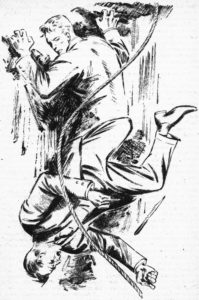
Stands on its own
“Satan’s Signature,” being reviewed here, turned out to be a pretty good detective yarn. If you didn’t know it had originally been a Shadow story, you probably wouldn’t have been able to tell by reading it. The obvious traces of its ancestry have been removed. This was not a matter of simply changing the character names and leaving the story alone. Rather, their entire personalities were rewritten. Scenes were modified. And what was published a year later in Clues was a fun detective story with the Tinsley touch.
The story opens as detective Walt Kenny has been called to the estate of millionaire Andrew Thorpe in the middle of the night. Thorpe, who had called him, died five minutes earlier from a heart attack.
The people in the house are Ned and Alice Thorpe, identical twins and orphans living with their uncle; Mrs. Martha Jackson, a widowed elderly second cousin of the dead man; a burly butler by the name of Chester; and Doctor Derby, who had been attending Mr. Thorpe; and his nurse, Miss Cunningham. Also, two maids and a cook.
Earlier that day Thorpe had executed a new will, witnessed by John Strickland, his lawyer, and by Chester, the butler. Kenny finds it in an unlocked safe. According to the terms of the will, the twins get a half million each. Martha Jackson gets $25,000. The servants get a thousand each. There are some small bequests to charities. And… a mystery man by the name of Herbert Logan gets a full million.
Within the hour, Chester, the butler, is stabbed through the heart. That leaves only one witness to the will: John Strickland, the lawyer. He is found dead soon after. Now, Walt Kenny must unravel the mystery of the murders… and the unknown Herbert Logan. And all is finally revealed in a drawing room confrontation right out of The Thin Man or Charlie Chan. And the killer is… well, just go back and read the spoiler, if you really want to know.
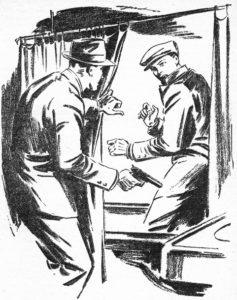
Hints of The Shadow
As I read this story, I kept looking for hints of The Shadow. They were there. Read this passage: “A flashlight glowed suddenly behind the wheel of the car. The lens of the torch was taped. A beam no broader than a lead pencil played across Kenny’s face as he bent close toward the seat.” The flashlight lens masked off with tape… how many times have we read that in The Shadow novels?
In one place, Walt Kenny calls his secretary to get an address for a phone number. In The Shadow version, this would obviously be the place where The Shadow called Burbank and had him use his reverse-lookup directory.
And consider the following scene: Walt Kenny discovers an underground passage taken by a thug. Far inside, there is a deep pit and a rope leading down. There is an exciting confrontation between Kenny hanging from the rope, and the thug, at the top with a knife. I would have loved to read this scene as it was originally staged with The Shadow. It was very well done, and would have been a high point of the pulp. And it’s not too hard to imagine.
In Tinsley’s Shadow stories, he wrote some pretty cool death traps for The Shadow to avoid. There’s a real corker in this reworked Shadow tale. Aboard a cabin cruiser, The Shadow… er, I mean Walt Kenny… is trapped by the master crook in a tiny cabin of the ship with phosgene gas being pumped in. And the room is booby trapped with lethal electricity. How he escapes is a real joy to read. It would have been another thrilling highpoint of the Shadow story, had it been published as such.
Theodore Tinsley was noted for playing a little fast and loose with reality, and it shows here in a few spots. In the finale of the story, Alice explains she was able to successfully impersonate her brother. “The deception was easy because Ned and I are, as you know, identical twins.” The problem, there, is that identical twins are always of the same sex. In the case of Alice and Ned, they would have been fraternal twins, not identical. And the impersonation ploy likely wouldn’t have worked. I guess that’s why they call it pulp fiction.
In the climax, Inspector Cardona (Okay, he’s called Inspector Swanson, here) is wary of a small glass vial that Martha Jackson claims contains nitroglycerin. “He knew nitro when he saw it!” And here again, Tinsley stretches the facts a bit. Since nitroglycerin is a colorless liquid, he wouldn’t know it when he saw it. That glass vial could just have easily been filled with water or oil, both also colorless. But we must keep in mind that this was pulp… and as such we can’t be too demanding.
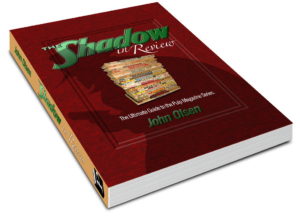
The original version
After reading this story, I pondered the question, could this story have been salvaged for The Shadow Magazine? Admittedly, the ending did not fit with Street & Smith’s editorial guidelines for The Shadow. There was really no way to make adjustments, since the whole story was written around the final finish. Having the villain be a man… even a man wearing the disguise of an old woman… might have conformed to Street & Smith’s standards, but then would have contradicted some of the basic clues set up earlier in the story. So I understand the editorial decision not to use it.
But I still wish I could read the original version, where The Shadow was the hero. But alas, that version seems to be lost to the ages. I’ve never detected even a hint that the original version survived. Instead, all we are left with is the rewritten version as published in Clues. It’s still worth the time to read, though.
It’s a quite enjoyable pulp adventure/mystery that shows off Tinsley’s pulp skills. Most signs of its Shadowy origins have been erased, so you shouldn’t expect to enjoy it as a Shadow novel. Only a few tantalizing hints remain. Instead, enjoy it as a fun pulp romp with Walt Kenny, private detective. And dream of “what if…”
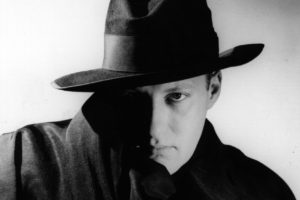
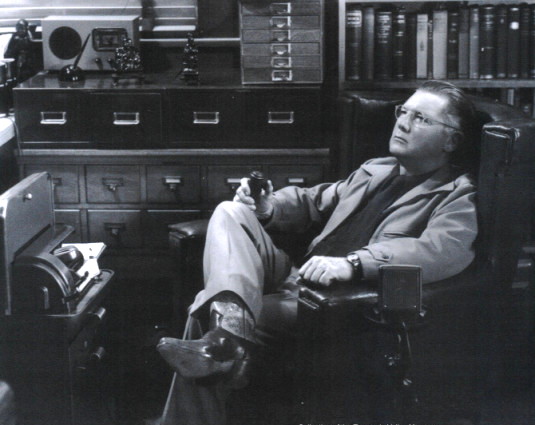

“Satan’s Signature” sounds more like a Spider title. In fact, the whole story sounds tailor-made for the Master of Men! His blood-and-thunder adventures never bothered with logic!
I’d bet that if the Spider came from the same publishing house as The Shadow, it would have snapped up the story. My guess is that Tinsley had some sort of legal agreement with Street & Smith that gave them first rights to the story. And they exercised that right.
I always think of the Spider as The Shadow on steroids. And I agree, that this story would have worked for the Spider. Maybe the Spider editors would have asked Tinsley to insert a little more gore, even.